Powell’s speech, Nvidia’s chips, Meta deal - what’s moving markets
Introduction & Market Context
Bakkt Holdings Inc (NYSE:BKKT) presented its second quarter 2025 earnings on August 11, showcasing its strategic realignment toward becoming a pure-play cryptocurrency infrastructure company. The presentation comes as the broader digital asset market continues to mature, with the company highlighting the significant growth potential in the space.
Bakkt’s stock closed at $10.81 on the day of the presentation, dropping 8.23% in regular trading but recovering slightly with a 0.37% gain in after-hours trading. The company’s strategic pivot comes amid a challenging market environment, with the stock experiencing high volatility as reflected in its 52-week range of $6.81 to $37.21.
The company positioned its transformation within the context of a massive potential total addressable market, emphasizing the relative size of various asset classes and the growth opportunity for digital assets.
As shown in the following chart of global asset classes and market sizes:
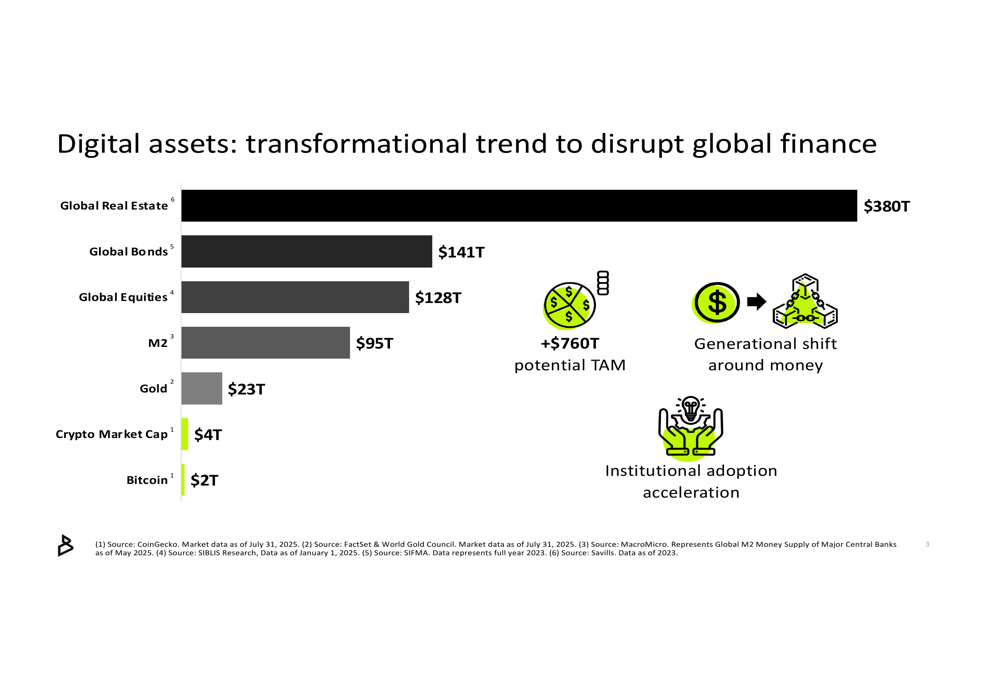
Strategic Initiatives
Bakkt’s presentation outlined a comprehensive strategic realignment focused on three core pillars: Brokerage-in-a-box 2.0, Stablecoin Payments, and Bitcoin treasury strategy. The company has completed the divestiture of its Custody business and has a definitive agreement for the sale of its Loyalty business, marking a decisive shift toward its new focus areas.
The company’s strategic transformation is illustrated in this overview:

The three pillars of Bakkt’s new crypto platform strategy encompass technology upgrades, payment infrastructure improvements, and Bitcoin treasury expansion:
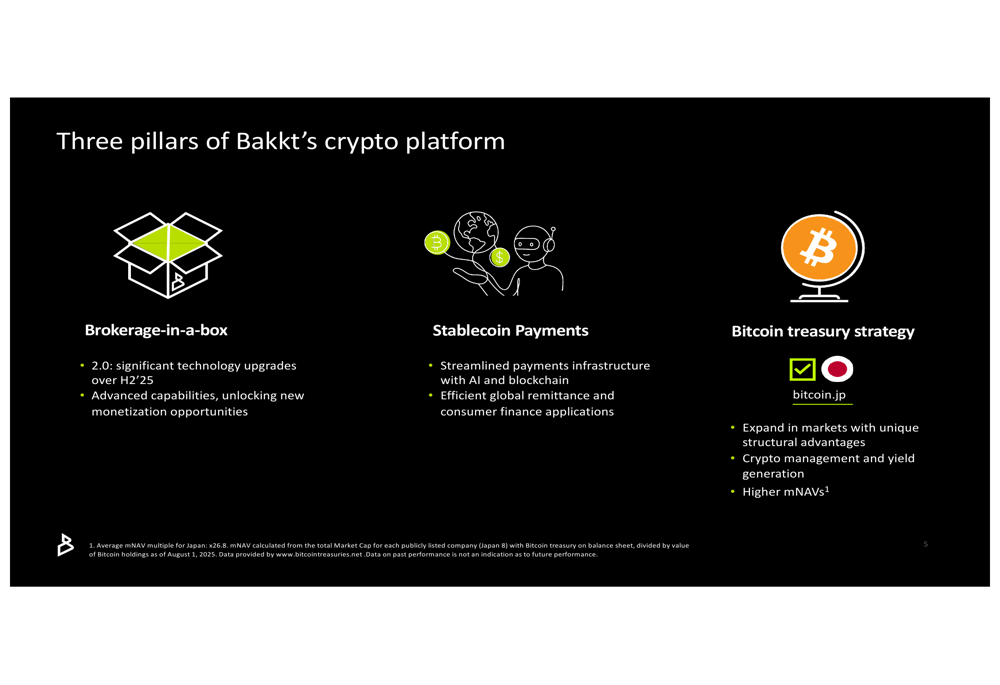
A key component of Bakkt’s strategy is the enhancement of its Brokerage-in-a-box offering to version 2.0, which will include significant technology upgrades scheduled for the second half of 2025. The upgraded platform will feature over 200 available assets, an advanced trading engine, social and copy trading capabilities, and yield generation features.
The company is also advancing its stablecoin payments initiative through Bakkt Agent, an AI-powered plug-in for global money movement. This solution enables chat-based transfers and currently supports transfers to over 36 countries, with plans to expand to more than 90 countries in the next two quarters.
The Bakkt Agent interface is demonstrated in this illustration:
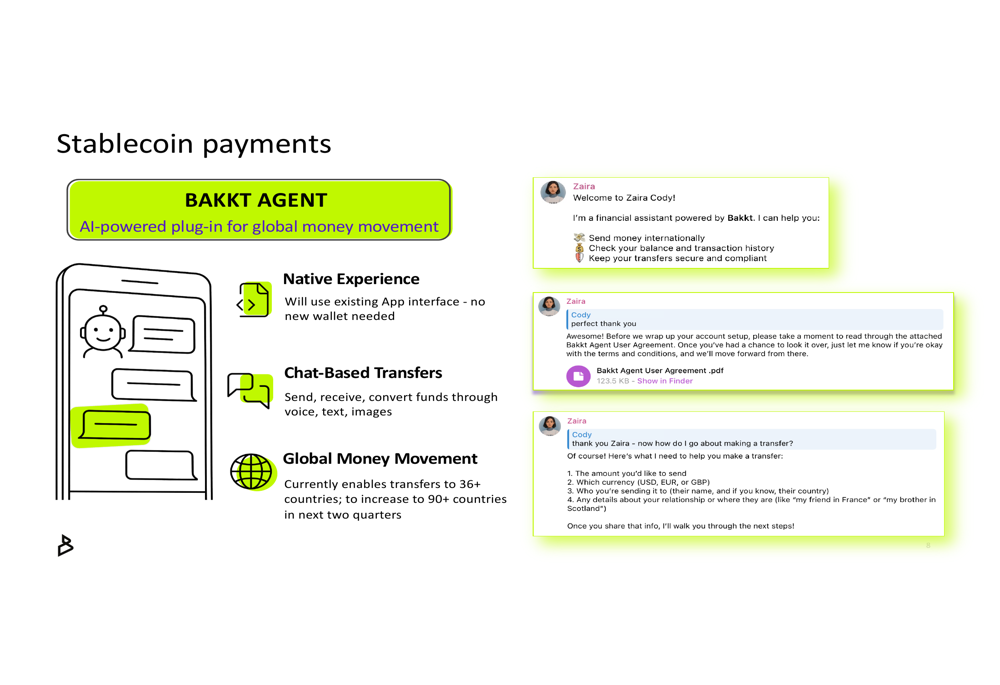
Quarterly Performance Highlights
Bakkt reported mixed financial results for Q2 2025, with some positive growth metrics alongside continued challenges. Trading volumes increased 14% year-over-year and 69% compared to Q2 2023, indicating growing activity on the platform despite market fluctuations.
The trading volume trends are visualized in this chart:
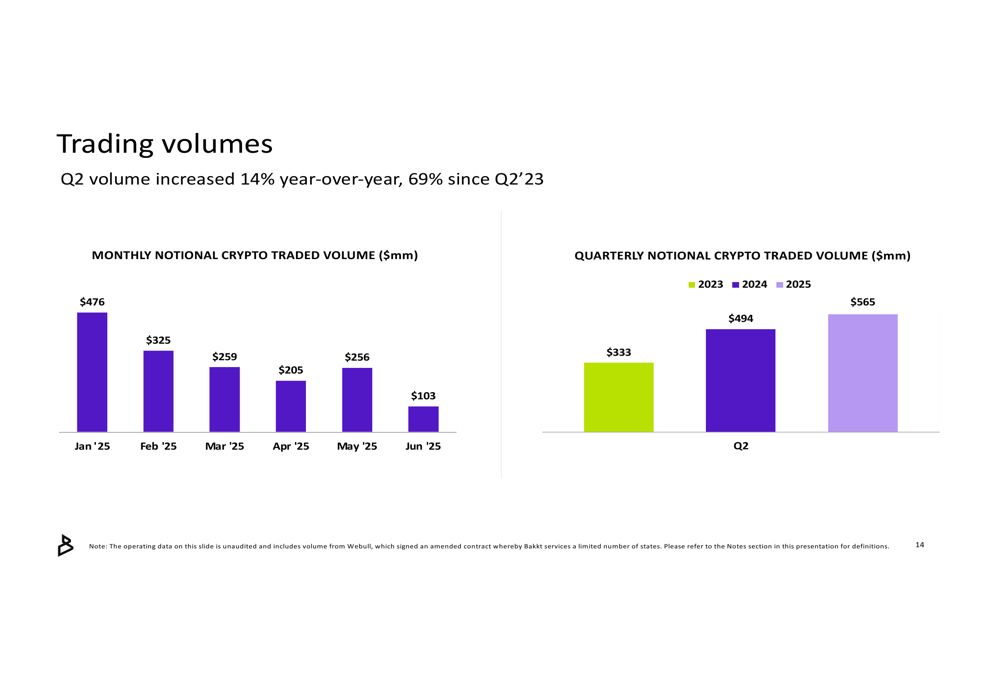
Key performance indicators showed some quarterly volatility, with transacting accounts declining quarter-over-quarter to 689,000 from 778,000 in Q1 2025. This represents a decrease from the 777,349 active accounts reported in the previous quarter. Notional traded volume was down 39.6% quarter-over-quarter but up 9.0% year-over-year, reaching $565 million.
Assets under custody decreased to $1.36 billion, primarily due to the divestiture of the Custody business. These metrics are illustrated in the following KPI overview:
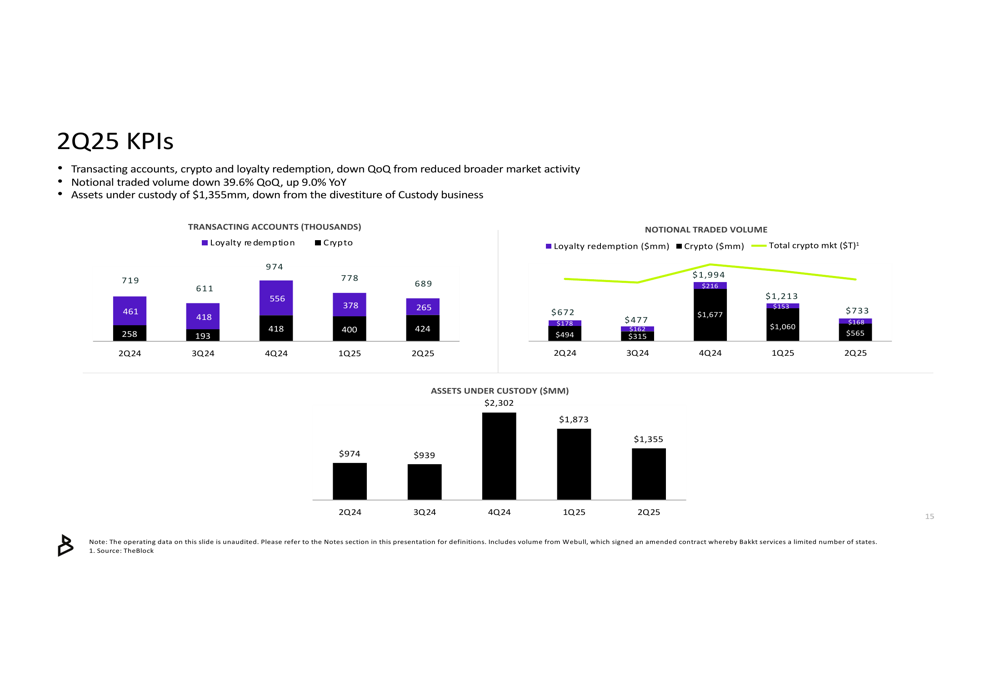
Detailed Financial Analysis
Bakkt’s Q2 2025 financial results showed gross revenues of $577.9 million, representing a 13.3% increase year-over-year. However, net revenues declined 23.3% year-over-year to $9.8 million. The company reported transaction revenues of $573.9 million and subscription and service revenues of $4.0 million.
The revenue breakdown by product category is shown here:
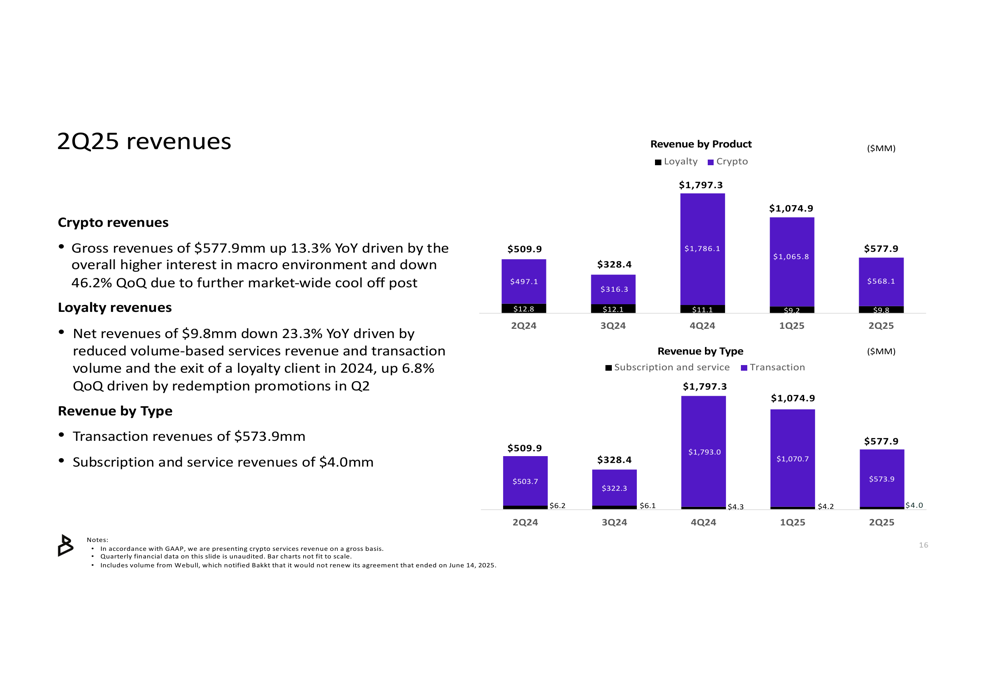
The company reported a net loss of $30.2 million for Q2 2025, which represents a 15.1% improvement compared to the same period last year. This contrasts with the net income growth reported in Q1 2025, indicating some quarter-to-quarter volatility in performance. Shares outstanding totaled 14.2 million, with net loss per share at $(2.16).
The condensed profit and loss statement provides additional details:
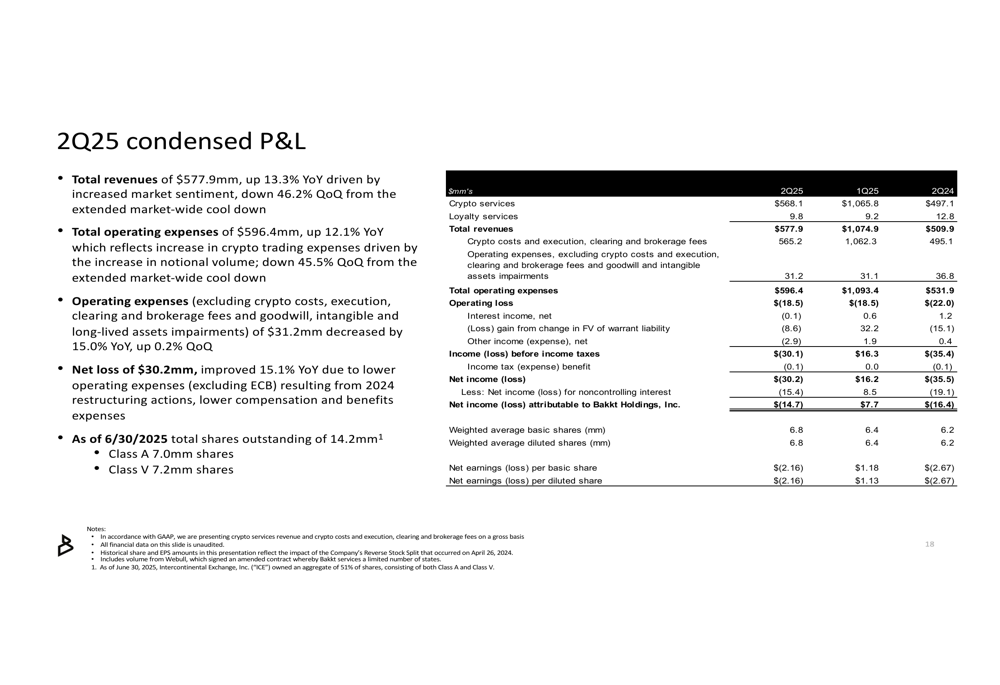
From a balance sheet perspective, Bakkt reported $61.5 million in cash and cash equivalents, an increase of $20.5 million. The company terminated its ICE line of credit on July 30, 2025, coinciding with a $75 million capital raise. Total (EPA:TTEF) assets stood at $190.1 million, with total liabilities of $132.3 million and total equity of $57.9 million.
The balance sheet summary is presented here:

Adjusted EBITDA, a non-GAAP measure, showed a loss of $12.6 million, which represents a 29.9% improvement year-over-year. This improvement suggests that the company’s cost control measures and strategic realignment are beginning to yield positive results despite the continued losses.
Forward-Looking Statements
Looking ahead, Bakkt outlined several immediate strategic priorities, including closing the loyalty divestiture, further optimizing its cost structure, launching the enhanced Brokerage-in-a-box 2.0, implementing stablecoin payments, and expanding its Bitcoin treasury strategy.
The company’s product rollout timeline indicates a private beta launch of Bakkt Agent in August 2025, with consumer rollout planned for the end of Q3 2025 and select business testing expected in Q4 2025. Future roadmap items include current and savings accounts, overnight interest-bearing accounts, and cards for local and international spending.
A significant element of Bakkt’s forward strategy is its Bitcoin treasury initiative, with an initial focus on Japan. The company has a 30% ownership stake in MHT, which is being rebranded to bitcoin.jp (subject to shareholder approval and other conditions). A strategic pivot is planned for an Extraordinary General Meeting in October 2025.
Bakkt’s transformation comes at a time when the company is working to position itself advantageously within the evolving cryptocurrency infrastructure landscape. While the financial results show continued challenges, the strategic realignment and focus on high-growth areas like stablecoin payments and Bitcoin treasury management suggest a clear direction for future development.
The success of this strategy will depend on the company’s ability to execute on its product roadmap, complete planned divestitures, and capitalize on the growing institutional adoption of cryptocurrency infrastructure solutions in an increasingly competitive market.
Full presentation:
This article was generated with the support of AI and reviewed by an editor. For more information see our T&C.
